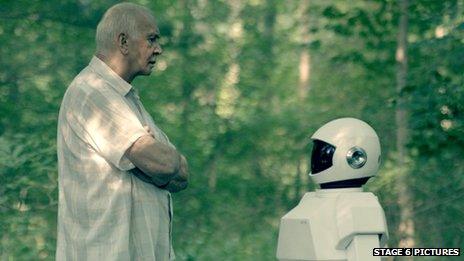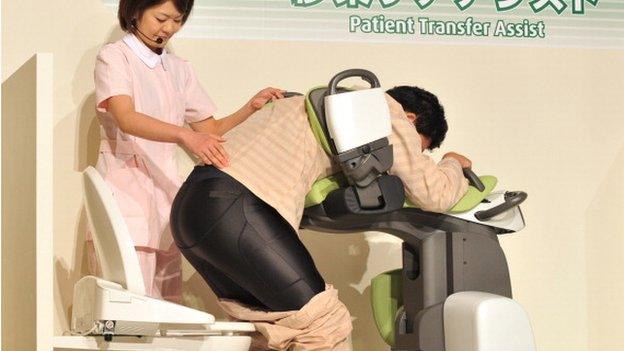'A robot is my friend': Can machines care for elderly?
- Published
Dan Simmons meets the researchers developing technology to help improve life for people in their later years.
With the world's elderly population growing rapidly, scientists are suggesting that robots could take on some of the burden of providing care, support and - most surprisingly - companionship.
A boy born today in Britain is expected to live on average, external to the age of 91, a girl to 94.
Worldwide 1.5 billion people over the age of 65 are expected to be around in 2050, external.
In Japan, which has the world's oldest population, Prime Minister Shinzo Abe has allocated 2.39bn yen (£14.3m) in the 2013 budget to develop robots to help with care.
Toyota is developing devices to help carry the elderly or provide mobility support , externaland Toli Corp has created a mat with a wireless sensor that can track and deliver feedback if an elderly person is moving around.
A special robot with 24 fingers, external has been developed for hair washing and head massage, useful if a person has limited arm movement. It is something Panasonic has also tried out in Japanese hair salons.
The idea of using robotics to care for the elderly is being trialled everywhere from Singapore to Salford.

Is the friendship between Frank Langella's character and his robot carer in the film Robot and Frank a sign of things to come?
The Spatio-Temporal Representations and Activities for Cognitive Control in Long-term Scenarios - handily referred to as the Strands project - at the University of Birmingham has received 8m euros (£6.69m) in funding from the European Commission.
The Strands robot will begin trials with an Austrian care provider in May, starting with simple things such as checking fire doors remain unblocked and defibrillators are always present and in the right place.
"We're trying to free up more of the staff time," says Dr Nick Hawes.
The robot is designed to take meals to residents
He says: "One of the biggest complaints of care home staff members is that they don't spend enough time doing the human interaction and the caring part.
"We're looking at porter-type tasks and assistance tasks. If the robot could fetch the tray of medicine while the human talks to the residents instead of getting the tray and just dishing out the medicine because they're short on time, it increases interaction."
But some projects are hoping robots can take a more active, and personable, approach to care.
Time for lunch?
The Mobiserv project - a consortium of eight European universities and care companies - has just finished research on creating, external a "social companion robot".
It could provide the elderly with everything from a health and nutrition coach that encourages them to eat healthily and exercise through to a device that lets them know they have not spoken to anyone for a while.
A project in Salford is creating robots that "can help supervise people 24 hours a day", according to researcher Antonio Espingardeiro.
The Carebot P37 S65 can, among other things, be programmed with speech therapy and object recognition exercises to help people with dementia.
Mr Espingardeiro and his team are currently looking at the comparative advantages and disadvantages between robot care and human care, but he believes robots can provide meaningful interaction to supplement human contact.

Toyota is creating robots that can assist with mobility, particularly for the elderly
As with a lot of technology, reality is taking its lead from science fiction. In the recent film Robot and Frank, an elderly man is bought a robot rather than being put into a care home.
There is evidence that robots offering companionship are popular with the elderly.
The most popular robot used by the older generation in Japan is Paro, a robot that will not help with the dishes, carry heavy items or administer medication.
But it does look cute, a cross between a seal and a Furby children's toy.

The seal-like Paro has become the most popular robot used by the elderly in Japan
It offers companionship rather than any tangible medical or physical support.
"Paro is my friend," says Japanese care home resident Kazuo Nashimura,
"I like it that he seems to understand human feelings."
Some of the robotic community thinks that this is not strictly in the mould of providing tangible benefits to the elderly.
"At no point is that a care robot," says Dr Hawes.
"There is really no benefit to having that except that it engages people, it facilitates conversation. If you're one on one with that robot, it's no more beneficial than having a Game Boy."
And the emotional reliance on robots seems to go against current campaigns by various charities for the elderly.
Age UK says half of all older people consider the television their main form of company and has set about a befriending service where people can volunteer, external to go around and chat with lonely people.
It is a service that they think would make a big difference, in a way that robots cannot.
"There is nothing wrong with making smarter use of technology to help people manage health conditions and possibly stay independent for longer," says Caroline Abrahams, charity director at Age UK.
"However, it is always important to ensure technology is only used where it delivers real benefits and to recognise that it is no substitute for the human touch."
Some see the robots as threatening to take the place of care staff or loved ones.
But with so many lonely elderly people, robots are seen by scientists working on robot projects as a first step.
"Some robotic device in a lonely person's life might improve it," says Dr Hawes.
"But that shouldn't disoblige society from finding new ways to give them human contact.
"The idea that we can say, 'Hey, let's give them a robot and we don't have to worry any more' is the scrapheap approach."
- Published28 August 2013
- Published4 February 2011
- Published14 November 2013
- Published26 February 2013
- Published14 November 2013